Analysis of BAT's Acquisition of RAI in the Global Financial Market
VerifiedAdded on 2023/04/25
|8
|2302
|78
Case Study
AI Summary
This case study examines British American Tobacco's (BAT) acquisition of Reynolds American Inc. (RAI) within the context of the global financial market. It provides background information on both companies, detailing their respective operations and product portfolios prior to the merger. The analysis covers the valuation of BAT and RAI before the acquisition, including a discussion of valuation approaches such as the discounted free cash flow method. The study also assesses the impact of the merger on both companies, considering market efficiency and investor reactions. It explores whether the market reaction to the acquisition announcement aligns with the efficient market hypothesis, investigating potential overreactions or underreactions. The case study references various academic sources to support its analysis and conclusions, ultimately providing a comprehensive overview of the financial implications and market dynamics surrounding the BAT-RAI merger. Desklib offers a platform for students to access this and similar solved assignments.
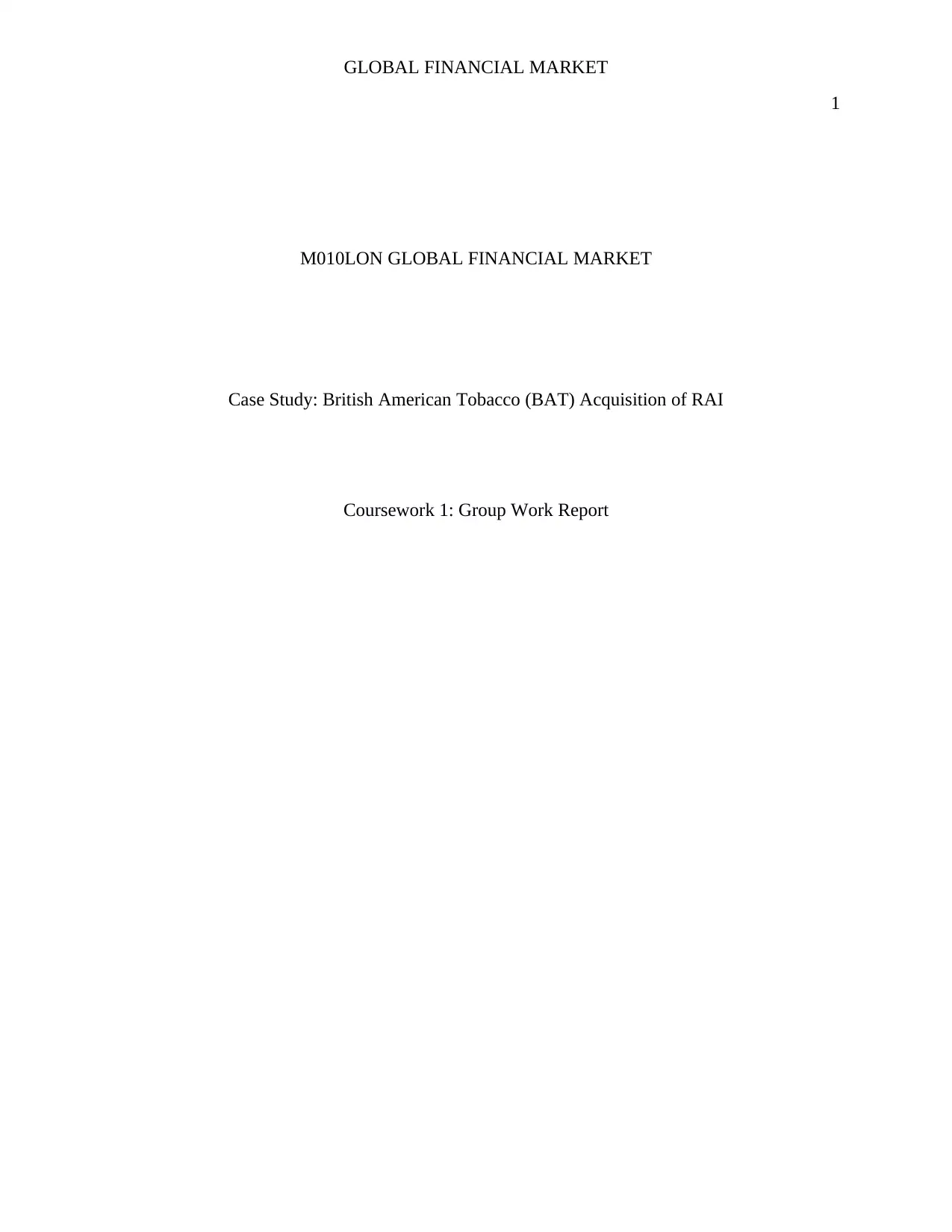
GLOBAL FINANCIAL MARKET
1
M010LON GLOBAL FINANCIAL MARKET
Case Study: British American Tobacco (BAT) Acquisition of RAI
Coursework 1: Group Work Report
1
M010LON GLOBAL FINANCIAL MARKET
Case Study: British American Tobacco (BAT) Acquisition of RAI
Coursework 1: Group Work Report
Paraphrase This Document
Need a fresh take? Get an instant paraphrase of this document with our AI Paraphraser
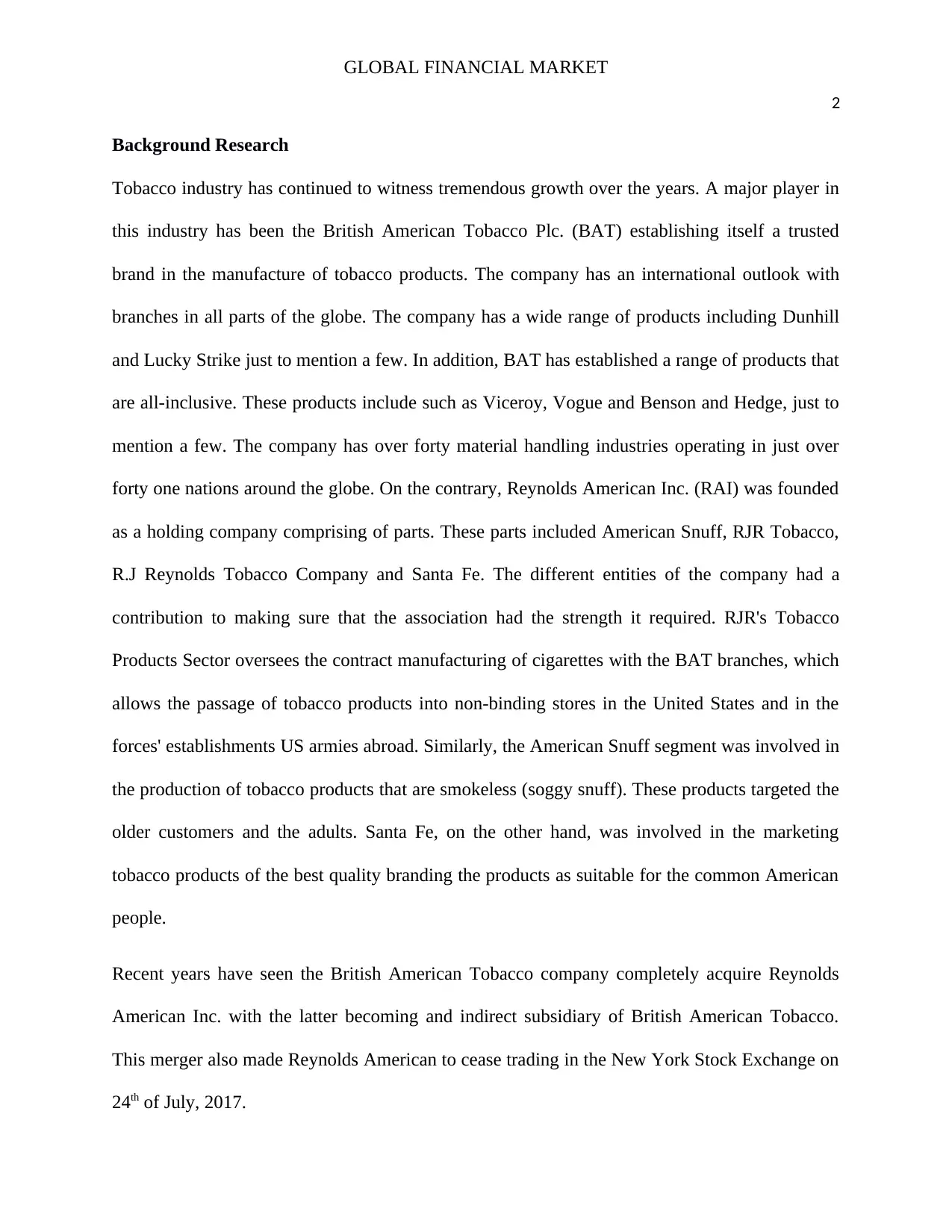
GLOBAL FINANCIAL MARKET
2
Background Research
Tobacco industry has continued to witness tremendous growth over the years. A major player in
this industry has been the British American Tobacco Plc. (BAT) establishing itself a trusted
brand in the manufacture of tobacco products. The company has an international outlook with
branches in all parts of the globe. The company has a wide range of products including Dunhill
and Lucky Strike just to mention a few. In addition, BAT has established a range of products that
are all-inclusive. These products include such as Viceroy, Vogue and Benson and Hedge, just to
mention a few. The company has over forty material handling industries operating in just over
forty one nations around the globe. On the contrary, Reynolds American Inc. (RAI) was founded
as a holding company comprising of parts. These parts included American Snuff, RJR Tobacco,
R.J Reynolds Tobacco Company and Santa Fe. The different entities of the company had a
contribution to making sure that the association had the strength it required. RJR's Tobacco
Products Sector oversees the contract manufacturing of cigarettes with the BAT branches, which
allows the passage of tobacco products into non-binding stores in the United States and in the
forces' establishments US armies abroad. Similarly, the American Snuff segment was involved in
the production of tobacco products that are smokeless (soggy snuff). These products targeted the
older customers and the adults. Santa Fe, on the other hand, was involved in the marketing
tobacco products of the best quality branding the products as suitable for the common American
people.
Recent years have seen the British American Tobacco company completely acquire Reynolds
American Inc. with the latter becoming and indirect subsidiary of British American Tobacco.
This merger also made Reynolds American to cease trading in the New York Stock Exchange on
24th of July, 2017.
2
Background Research
Tobacco industry has continued to witness tremendous growth over the years. A major player in
this industry has been the British American Tobacco Plc. (BAT) establishing itself a trusted
brand in the manufacture of tobacco products. The company has an international outlook with
branches in all parts of the globe. The company has a wide range of products including Dunhill
and Lucky Strike just to mention a few. In addition, BAT has established a range of products that
are all-inclusive. These products include such as Viceroy, Vogue and Benson and Hedge, just to
mention a few. The company has over forty material handling industries operating in just over
forty one nations around the globe. On the contrary, Reynolds American Inc. (RAI) was founded
as a holding company comprising of parts. These parts included American Snuff, RJR Tobacco,
R.J Reynolds Tobacco Company and Santa Fe. The different entities of the company had a
contribution to making sure that the association had the strength it required. RJR's Tobacco
Products Sector oversees the contract manufacturing of cigarettes with the BAT branches, which
allows the passage of tobacco products into non-binding stores in the United States and in the
forces' establishments US armies abroad. Similarly, the American Snuff segment was involved in
the production of tobacco products that are smokeless (soggy snuff). These products targeted the
older customers and the adults. Santa Fe, on the other hand, was involved in the marketing
tobacco products of the best quality branding the products as suitable for the common American
people.
Recent years have seen the British American Tobacco company completely acquire Reynolds
American Inc. with the latter becoming and indirect subsidiary of British American Tobacco.
This merger also made Reynolds American to cease trading in the New York Stock Exchange on
24th of July, 2017.
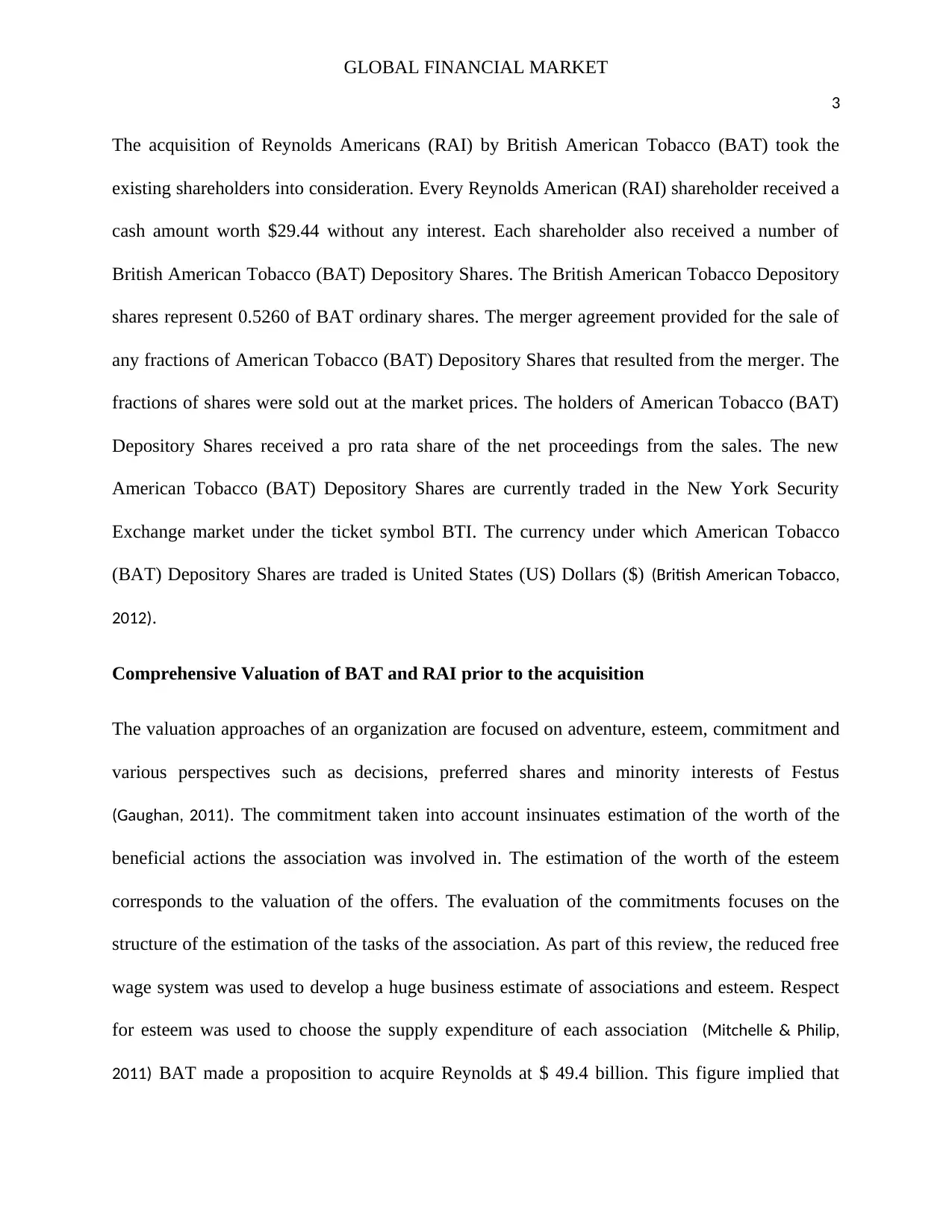
GLOBAL FINANCIAL MARKET
3
The acquisition of Reynolds Americans (RAI) by British American Tobacco (BAT) took the
existing shareholders into consideration. Every Reynolds American (RAI) shareholder received a
cash amount worth $29.44 without any interest. Each shareholder also received a number of
British American Tobacco (BAT) Depository Shares. The British American Tobacco Depository
shares represent 0.5260 of BAT ordinary shares. The merger agreement provided for the sale of
any fractions of American Tobacco (BAT) Depository Shares that resulted from the merger. The
fractions of shares were sold out at the market prices. The holders of American Tobacco (BAT)
Depository Shares received a pro rata share of the net proceedings from the sales. The new
American Tobacco (BAT) Depository Shares are currently traded in the New York Security
Exchange market under the ticket symbol BTI. The currency under which American Tobacco
(BAT) Depository Shares are traded is United States (US) Dollars ($) (British American Tobacco,
2012).
Comprehensive Valuation of BAT and RAI prior to the acquisition
The valuation approaches of an organization are focused on adventure, esteem, commitment and
various perspectives such as decisions, preferred shares and minority interests of Festus
(Gaughan, 2011). The commitment taken into account insinuates estimation of the worth of the
beneficial actions the association was involved in. The estimation of the worth of the esteem
corresponds to the valuation of the offers. The evaluation of the commitments focuses on the
structure of the estimation of the tasks of the association. As part of this review, the reduced free
wage system was used to develop a huge business estimate of associations and esteem. Respect
for esteem was used to choose the supply expenditure of each association (Mitchelle & Philip,
2011) BAT made a proposition to acquire Reynolds at $ 49.4 billion. This figure implied that
3
The acquisition of Reynolds Americans (RAI) by British American Tobacco (BAT) took the
existing shareholders into consideration. Every Reynolds American (RAI) shareholder received a
cash amount worth $29.44 without any interest. Each shareholder also received a number of
British American Tobacco (BAT) Depository Shares. The British American Tobacco Depository
shares represent 0.5260 of BAT ordinary shares. The merger agreement provided for the sale of
any fractions of American Tobacco (BAT) Depository Shares that resulted from the merger. The
fractions of shares were sold out at the market prices. The holders of American Tobacco (BAT)
Depository Shares received a pro rata share of the net proceedings from the sales. The new
American Tobacco (BAT) Depository Shares are currently traded in the New York Security
Exchange market under the ticket symbol BTI. The currency under which American Tobacco
(BAT) Depository Shares are traded is United States (US) Dollars ($) (British American Tobacco,
2012).
Comprehensive Valuation of BAT and RAI prior to the acquisition
The valuation approaches of an organization are focused on adventure, esteem, commitment and
various perspectives such as decisions, preferred shares and minority interests of Festus
(Gaughan, 2011). The commitment taken into account insinuates estimation of the worth of the
beneficial actions the association was involved in. The estimation of the worth of the esteem
corresponds to the valuation of the offers. The evaluation of the commitments focuses on the
structure of the estimation of the tasks of the association. As part of this review, the reduced free
wage system was used to develop a huge business estimate of associations and esteem. Respect
for esteem was used to choose the supply expenditure of each association (Mitchelle & Philip,
2011) BAT made a proposition to acquire Reynolds at $ 49.4 billion. This figure implied that
⊘ This is a preview!⊘
Do you want full access?
Subscribe today to unlock all pages.

Trusted by 1+ million students worldwide
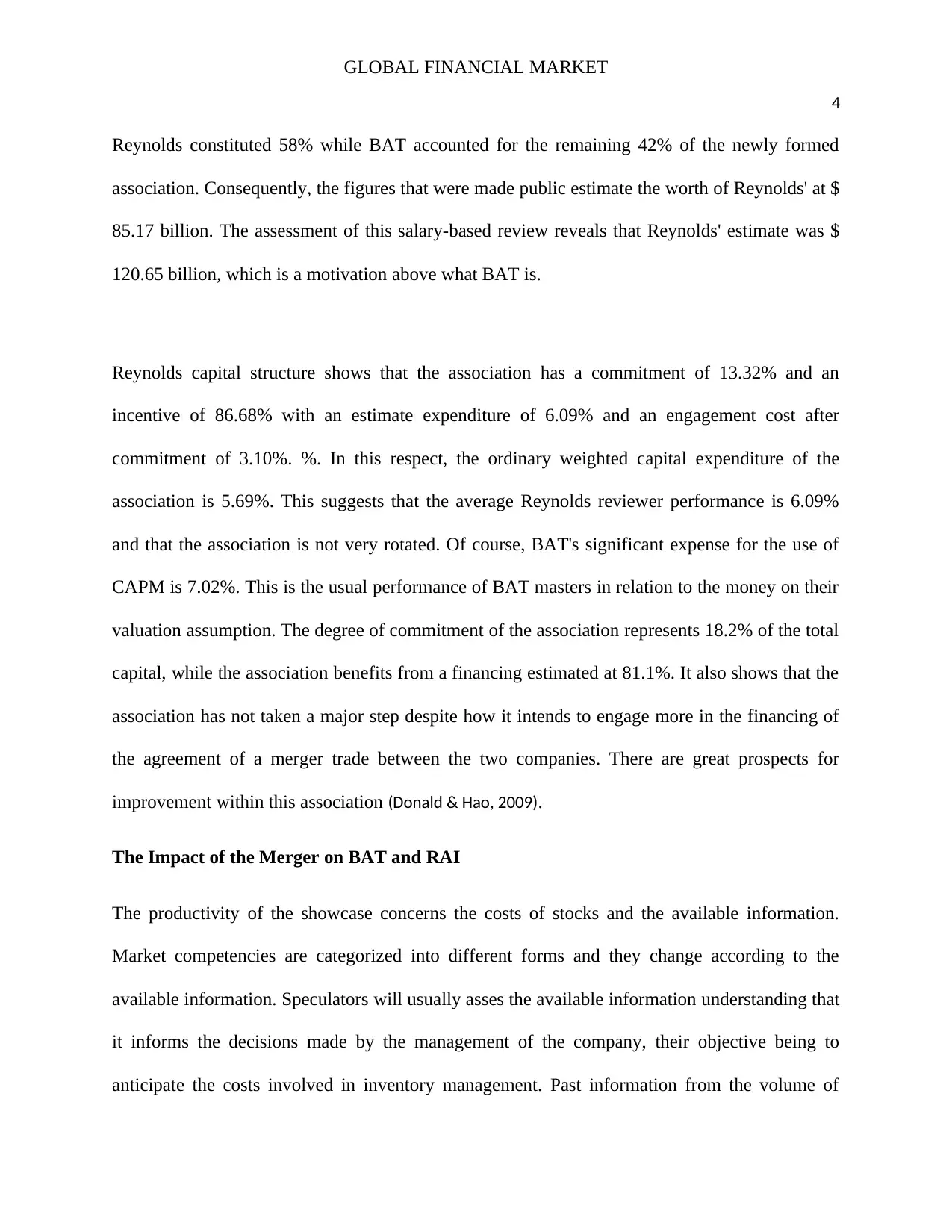
GLOBAL FINANCIAL MARKET
4
Reynolds constituted 58% while BAT accounted for the remaining 42% of the newly formed
association. Consequently, the figures that were made public estimate the worth of Reynolds' at $
85.17 billion. The assessment of this salary-based review reveals that Reynolds' estimate was $
120.65 billion, which is a motivation above what BAT is.
Reynolds capital structure shows that the association has a commitment of 13.32% and an
incentive of 86.68% with an estimate expenditure of 6.09% and an engagement cost after
commitment of 3.10%. %. In this respect, the ordinary weighted capital expenditure of the
association is 5.69%. This suggests that the average Reynolds reviewer performance is 6.09%
and that the association is not very rotated. Of course, BAT's significant expense for the use of
CAPM is 7.02%. This is the usual performance of BAT masters in relation to the money on their
valuation assumption. The degree of commitment of the association represents 18.2% of the total
capital, while the association benefits from a financing estimated at 81.1%. It also shows that the
association has not taken a major step despite how it intends to engage more in the financing of
the agreement of a merger trade between the two companies. There are great prospects for
improvement within this association (Donald & Hao, 2009).
The Impact of the Merger on BAT and RAI
The productivity of the showcase concerns the costs of stocks and the available information.
Market competencies are categorized into different forms and they change according to the
available information. Speculators will usually asses the available information understanding that
it informs the decisions made by the management of the company, their objective being to
anticipate the costs involved in inventory management. Past information from the volume of
4
Reynolds constituted 58% while BAT accounted for the remaining 42% of the newly formed
association. Consequently, the figures that were made public estimate the worth of Reynolds' at $
85.17 billion. The assessment of this salary-based review reveals that Reynolds' estimate was $
120.65 billion, which is a motivation above what BAT is.
Reynolds capital structure shows that the association has a commitment of 13.32% and an
incentive of 86.68% with an estimate expenditure of 6.09% and an engagement cost after
commitment of 3.10%. %. In this respect, the ordinary weighted capital expenditure of the
association is 5.69%. This suggests that the average Reynolds reviewer performance is 6.09%
and that the association is not very rotated. Of course, BAT's significant expense for the use of
CAPM is 7.02%. This is the usual performance of BAT masters in relation to the money on their
valuation assumption. The degree of commitment of the association represents 18.2% of the total
capital, while the association benefits from a financing estimated at 81.1%. It also shows that the
association has not taken a major step despite how it intends to engage more in the financing of
the agreement of a merger trade between the two companies. There are great prospects for
improvement within this association (Donald & Hao, 2009).
The Impact of the Merger on BAT and RAI
The productivity of the showcase concerns the costs of stocks and the available information.
Market competencies are categorized into different forms and they change according to the
available information. Speculators will usually asses the available information understanding that
it informs the decisions made by the management of the company, their objective being to
anticipate the costs involved in inventory management. Past information from the volume of
Paraphrase This Document
Need a fresh take? Get an instant paraphrase of this document with our AI Paraphraser
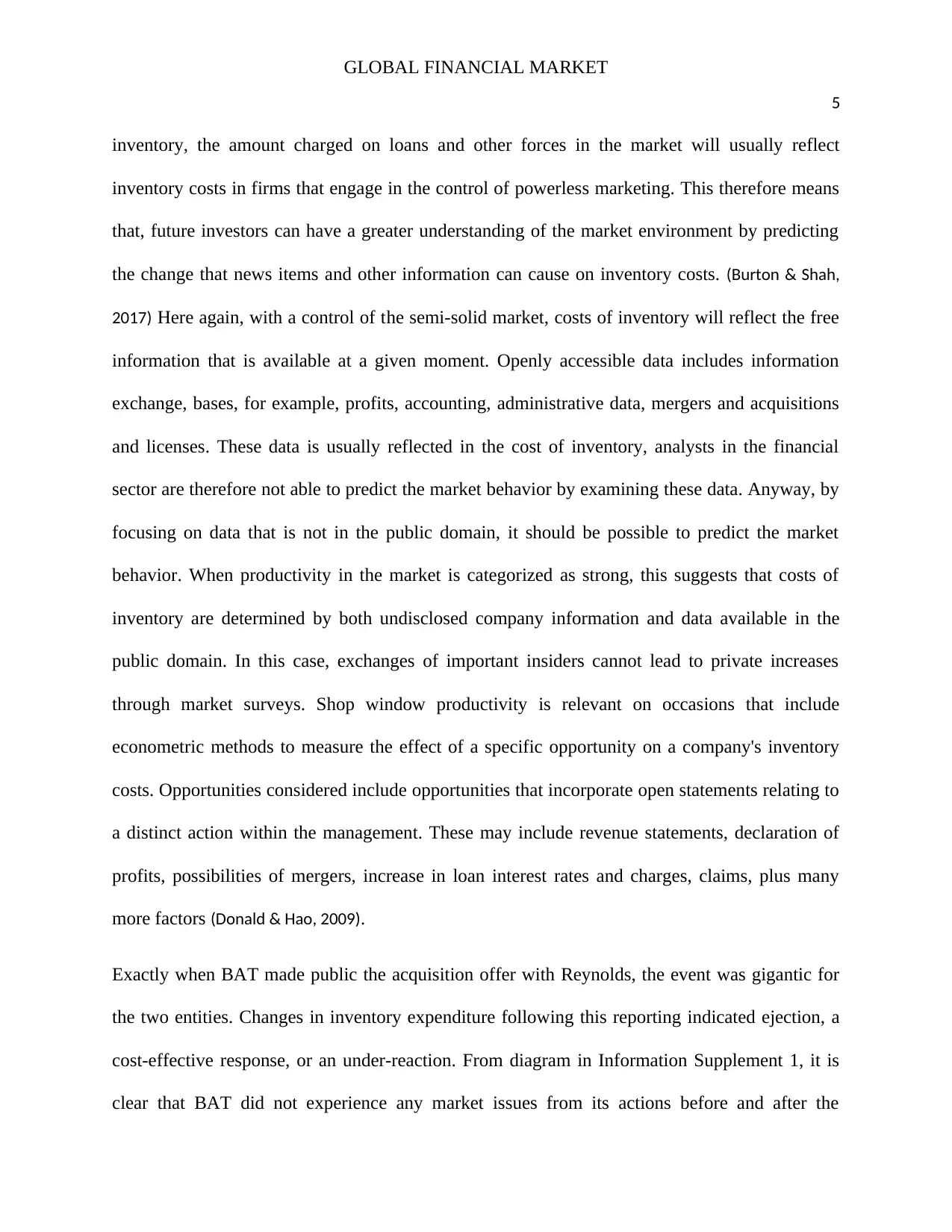
GLOBAL FINANCIAL MARKET
5
inventory, the amount charged on loans and other forces in the market will usually reflect
inventory costs in firms that engage in the control of powerless marketing. This therefore means
that, future investors can have a greater understanding of the market environment by predicting
the change that news items and other information can cause on inventory costs. (Burton & Shah,
2017) Here again, with a control of the semi-solid market, costs of inventory will reflect the free
information that is available at a given moment. Openly accessible data includes information
exchange, bases, for example, profits, accounting, administrative data, mergers and acquisitions
and licenses. These data is usually reflected in the cost of inventory, analysts in the financial
sector are therefore not able to predict the market behavior by examining these data. Anyway, by
focusing on data that is not in the public domain, it should be possible to predict the market
behavior. When productivity in the market is categorized as strong, this suggests that costs of
inventory are determined by both undisclosed company information and data available in the
public domain. In this case, exchanges of important insiders cannot lead to private increases
through market surveys. Shop window productivity is relevant on occasions that include
econometric methods to measure the effect of a specific opportunity on a company's inventory
costs. Opportunities considered include opportunities that incorporate open statements relating to
a distinct action within the management. These may include revenue statements, declaration of
profits, possibilities of mergers, increase in loan interest rates and charges, claims, plus many
more factors (Donald & Hao, 2009).
Exactly when BAT made public the acquisition offer with Reynolds, the event was gigantic for
the two entities. Changes in inventory expenditure following this reporting indicated ejection, a
cost-effective response, or an under-reaction. From diagram in Information Supplement 1, it is
clear that BAT did not experience any market issues from its actions before and after the
5
inventory, the amount charged on loans and other forces in the market will usually reflect
inventory costs in firms that engage in the control of powerless marketing. This therefore means
that, future investors can have a greater understanding of the market environment by predicting
the change that news items and other information can cause on inventory costs. (Burton & Shah,
2017) Here again, with a control of the semi-solid market, costs of inventory will reflect the free
information that is available at a given moment. Openly accessible data includes information
exchange, bases, for example, profits, accounting, administrative data, mergers and acquisitions
and licenses. These data is usually reflected in the cost of inventory, analysts in the financial
sector are therefore not able to predict the market behavior by examining these data. Anyway, by
focusing on data that is not in the public domain, it should be possible to predict the market
behavior. When productivity in the market is categorized as strong, this suggests that costs of
inventory are determined by both undisclosed company information and data available in the
public domain. In this case, exchanges of important insiders cannot lead to private increases
through market surveys. Shop window productivity is relevant on occasions that include
econometric methods to measure the effect of a specific opportunity on a company's inventory
costs. Opportunities considered include opportunities that incorporate open statements relating to
a distinct action within the management. These may include revenue statements, declaration of
profits, possibilities of mergers, increase in loan interest rates and charges, claims, plus many
more factors (Donald & Hao, 2009).
Exactly when BAT made public the acquisition offer with Reynolds, the event was gigantic for
the two entities. Changes in inventory expenditure following this reporting indicated ejection, a
cost-effective response, or an under-reaction. From diagram in Information Supplement 1, it is
clear that BAT did not experience any market issues from its actions before and after the
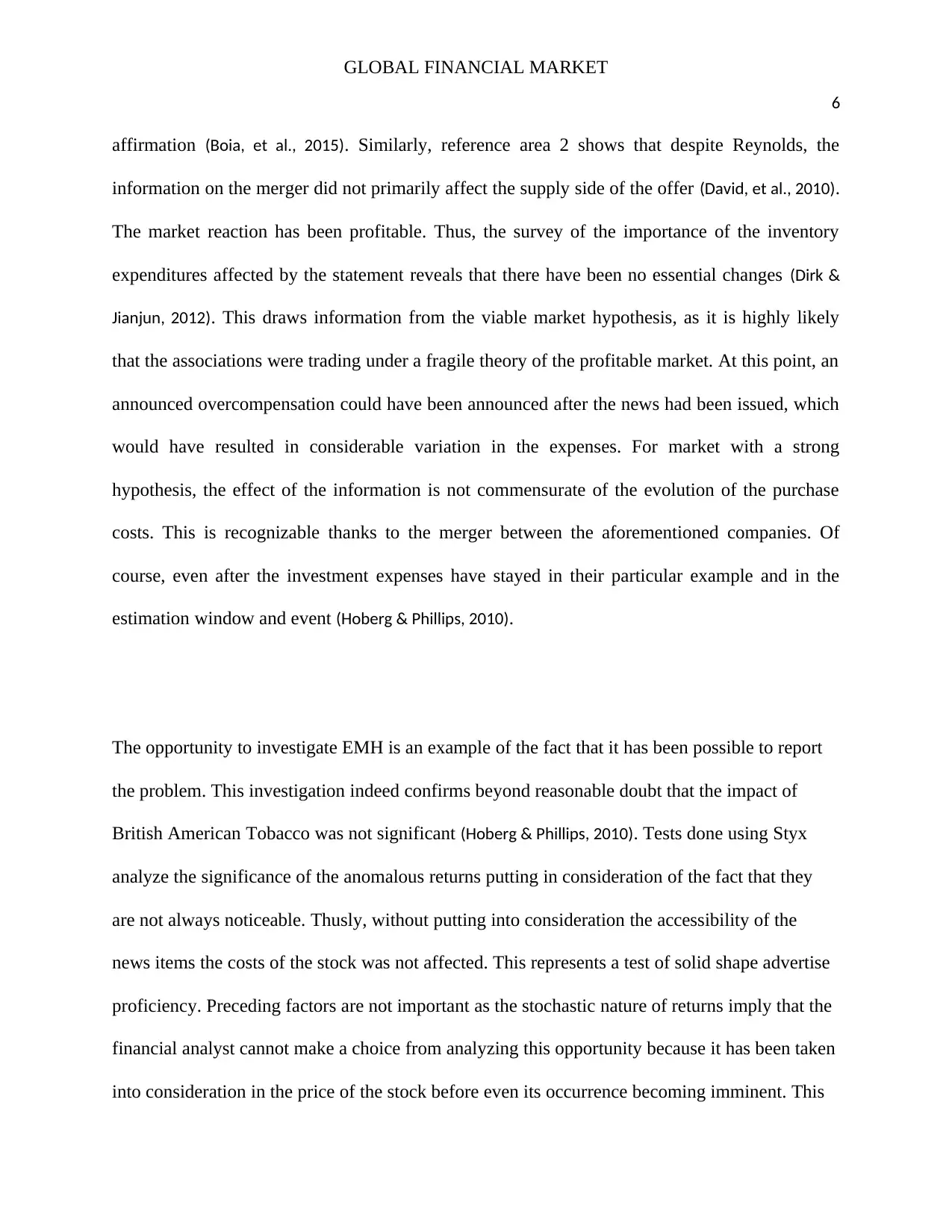
GLOBAL FINANCIAL MARKET
6
affirmation (Boia, et al., 2015). Similarly, reference area 2 shows that despite Reynolds, the
information on the merger did not primarily affect the supply side of the offer (David, et al., 2010).
The market reaction has been profitable. Thus, the survey of the importance of the inventory
expenditures affected by the statement reveals that there have been no essential changes (Dirk &
Jianjun, 2012). This draws information from the viable market hypothesis, as it is highly likely
that the associations were trading under a fragile theory of the profitable market. At this point, an
announced overcompensation could have been announced after the news had been issued, which
would have resulted in considerable variation in the expenses. For market with a strong
hypothesis, the effect of the information is not commensurate of the evolution of the purchase
costs. This is recognizable thanks to the merger between the aforementioned companies. Of
course, even after the investment expenses have stayed in their particular example and in the
estimation window and event (Hoberg & Phillips, 2010).
The opportunity to investigate EMH is an example of the fact that it has been possible to report
the problem. This investigation indeed confirms beyond reasonable doubt that the impact of
British American Tobacco was not significant (Hoberg & Phillips, 2010). Tests done using Styx
analyze the significance of the anomalous returns putting in consideration of the fact that they
are not always noticeable. Thusly, without putting into consideration the accessibility of the
news items the costs of the stock was not affected. This represents a test of solid shape advertise
proficiency. Preceding factors are not important as the stochastic nature of returns imply that the
financial analyst cannot make a choice from analyzing this opportunity because it has been taken
into consideration in the price of the stock before even its occurrence becoming imminent. This
6
affirmation (Boia, et al., 2015). Similarly, reference area 2 shows that despite Reynolds, the
information on the merger did not primarily affect the supply side of the offer (David, et al., 2010).
The market reaction has been profitable. Thus, the survey of the importance of the inventory
expenditures affected by the statement reveals that there have been no essential changes (Dirk &
Jianjun, 2012). This draws information from the viable market hypothesis, as it is highly likely
that the associations were trading under a fragile theory of the profitable market. At this point, an
announced overcompensation could have been announced after the news had been issued, which
would have resulted in considerable variation in the expenses. For market with a strong
hypothesis, the effect of the information is not commensurate of the evolution of the purchase
costs. This is recognizable thanks to the merger between the aforementioned companies. Of
course, even after the investment expenses have stayed in their particular example and in the
estimation window and event (Hoberg & Phillips, 2010).
The opportunity to investigate EMH is an example of the fact that it has been possible to report
the problem. This investigation indeed confirms beyond reasonable doubt that the impact of
British American Tobacco was not significant (Hoberg & Phillips, 2010). Tests done using Styx
analyze the significance of the anomalous returns putting in consideration of the fact that they
are not always noticeable. Thusly, without putting into consideration the accessibility of the
news items the costs of the stock was not affected. This represents a test of solid shape advertise
proficiency. Preceding factors are not important as the stochastic nature of returns imply that the
financial analyst cannot make a choice from analyzing this opportunity because it has been taken
into consideration in the price of the stock before even its occurrence becoming imminent. This
⊘ This is a preview!⊘
Do you want full access?
Subscribe today to unlock all pages.

Trusted by 1+ million students worldwide
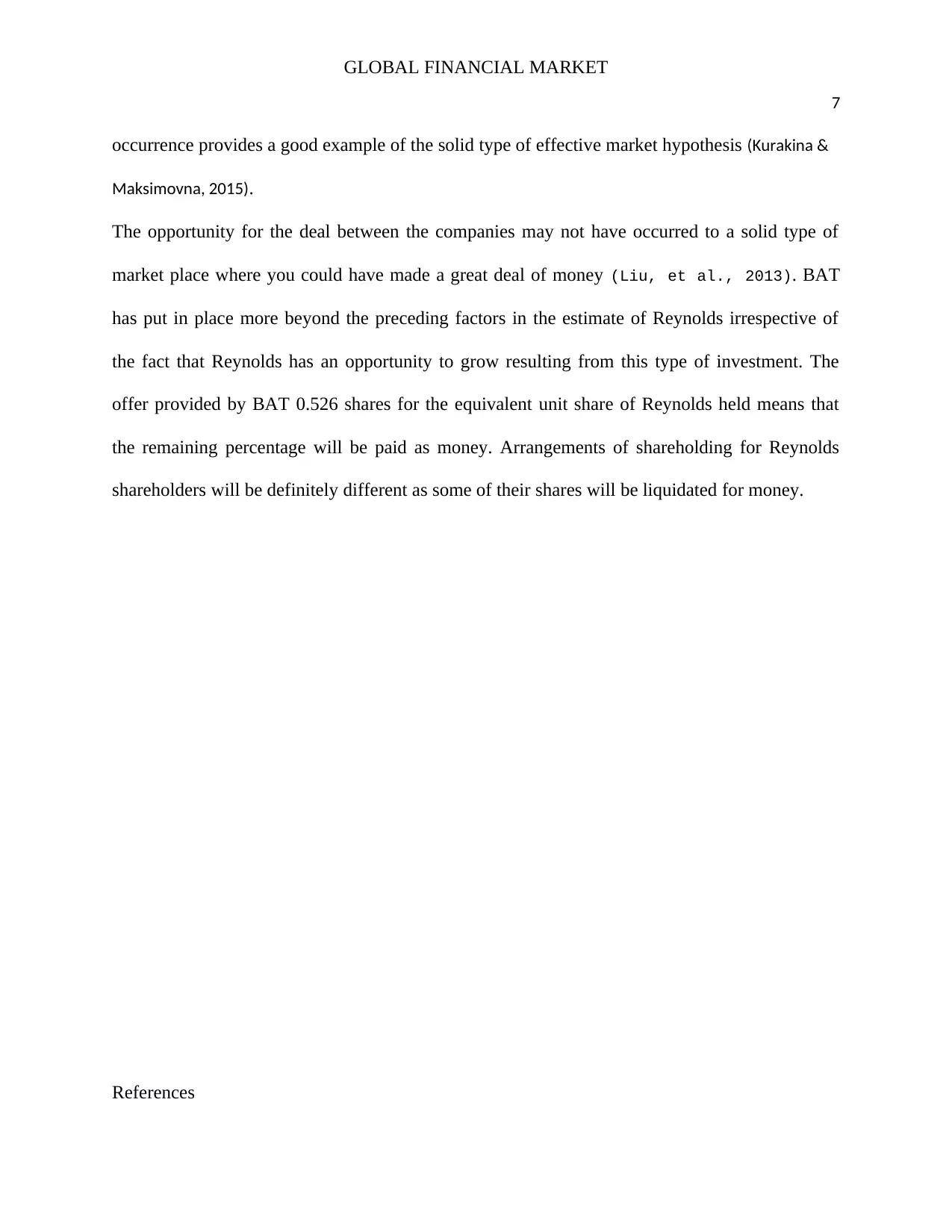
GLOBAL FINANCIAL MARKET
7
occurrence provides a good example of the solid type of effective market hypothesis (Kurakina &
Maksimovna, 2015).
The opportunity for the deal between the companies may not have occurred to a solid type of
market place where you could have made a great deal of money (Liu, et al., 2013). BAT
has put in place more beyond the preceding factors in the estimate of Reynolds irrespective of
the fact that Reynolds has an opportunity to grow resulting from this type of investment. The
offer provided by BAT 0.526 shares for the equivalent unit share of Reynolds held means that
the remaining percentage will be paid as money. Arrangements of shareholding for Reynolds
shareholders will be definitely different as some of their shares will be liquidated for money.
References
7
occurrence provides a good example of the solid type of effective market hypothesis (Kurakina &
Maksimovna, 2015).
The opportunity for the deal between the companies may not have occurred to a solid type of
market place where you could have made a great deal of money (Liu, et al., 2013). BAT
has put in place more beyond the preceding factors in the estimate of Reynolds irrespective of
the fact that Reynolds has an opportunity to grow resulting from this type of investment. The
offer provided by BAT 0.526 shares for the equivalent unit share of Reynolds held means that
the remaining percentage will be paid as money. Arrangements of shareholding for Reynolds
shareholders will be definitely different as some of their shares will be liquidated for money.
References
Paraphrase This Document
Need a fresh take? Get an instant paraphrase of this document with our AI Paraphraser
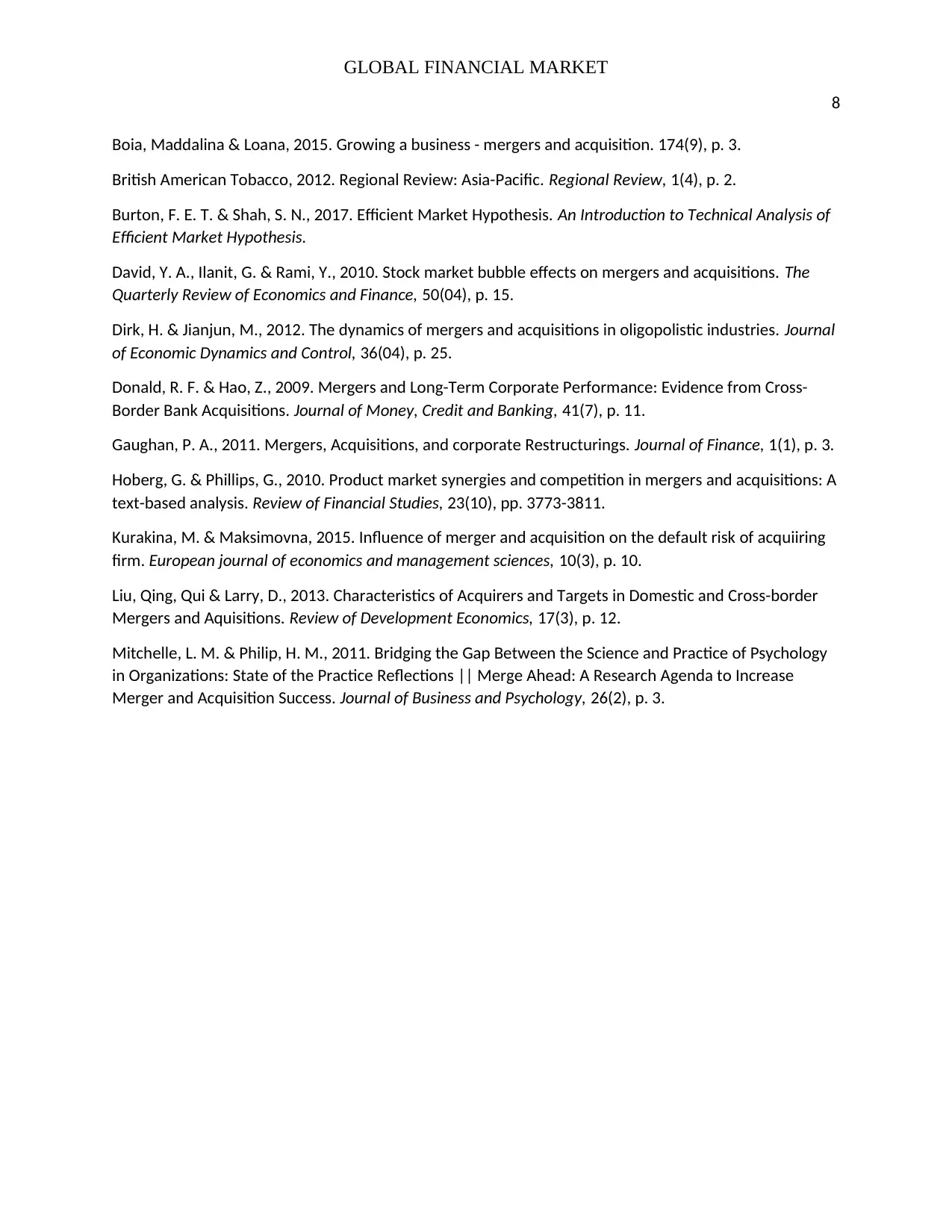
GLOBAL FINANCIAL MARKET
8
Boia, Maddalina & Loana, 2015. Growing a business - mergers and acquisition. 174(9), p. 3.
British American Tobacco, 2012. Regional Review: Asia-Pacific. Regional Review, 1(4), p. 2.
Burton, F. E. T. & Shah, S. N., 2017. Efficient Market Hypothesis. An Introduction to Technical Analysis of
Efficient Market Hypothesis.
David, Y. A., Ilanit, G. & Rami, Y., 2010. Stock market bubble effects on mergers and acquisitions. The
Quarterly Review of Economics and Finance, 50(04), p. 15.
Dirk, H. & Jianjun, M., 2012. The dynamics of mergers and acquisitions in oligopolistic industries. Journal
of Economic Dynamics and Control, 36(04), p. 25.
Donald, R. F. & Hao, Z., 2009. Mergers and Long-Term Corporate Performance: Evidence from Cross-
Border Bank Acquisitions. Journal of Money, Credit and Banking, 41(7), p. 11.
Gaughan, P. A., 2011. Mergers, Acquisitions, and corporate Restructurings. Journal of Finance, 1(1), p. 3.
Hoberg, G. & Phillips, G., 2010. Product market synergies and competition in mergers and acquisitions: A
text-based analysis. Review of Financial Studies, 23(10), pp. 3773-3811.
Kurakina, M. & Maksimovna, 2015. Influence of merger and acquisition on the default risk of acquiiring
firm. European journal of economics and management sciences, 10(3), p. 10.
Liu, Qing, Qui & Larry, D., 2013. Characteristics of Acquirers and Targets in Domestic and Cross-border
Mergers and Aquisitions. Review of Development Economics, 17(3), p. 12.
Mitchelle, L. M. & Philip, H. M., 2011. Bridging the Gap Between the Science and Practice of Psychology
in Organizations: State of the Practice Reflections || Merge Ahead: A Research Agenda to Increase
Merger and Acquisition Success. Journal of Business and Psychology, 26(2), p. 3.
8
Boia, Maddalina & Loana, 2015. Growing a business - mergers and acquisition. 174(9), p. 3.
British American Tobacco, 2012. Regional Review: Asia-Pacific. Regional Review, 1(4), p. 2.
Burton, F. E. T. & Shah, S. N., 2017. Efficient Market Hypothesis. An Introduction to Technical Analysis of
Efficient Market Hypothesis.
David, Y. A., Ilanit, G. & Rami, Y., 2010. Stock market bubble effects on mergers and acquisitions. The
Quarterly Review of Economics and Finance, 50(04), p. 15.
Dirk, H. & Jianjun, M., 2012. The dynamics of mergers and acquisitions in oligopolistic industries. Journal
of Economic Dynamics and Control, 36(04), p. 25.
Donald, R. F. & Hao, Z., 2009. Mergers and Long-Term Corporate Performance: Evidence from Cross-
Border Bank Acquisitions. Journal of Money, Credit and Banking, 41(7), p. 11.
Gaughan, P. A., 2011. Mergers, Acquisitions, and corporate Restructurings. Journal of Finance, 1(1), p. 3.
Hoberg, G. & Phillips, G., 2010. Product market synergies and competition in mergers and acquisitions: A
text-based analysis. Review of Financial Studies, 23(10), pp. 3773-3811.
Kurakina, M. & Maksimovna, 2015. Influence of merger and acquisition on the default risk of acquiiring
firm. European journal of economics and management sciences, 10(3), p. 10.
Liu, Qing, Qui & Larry, D., 2013. Characteristics of Acquirers and Targets in Domestic and Cross-border
Mergers and Aquisitions. Review of Development Economics, 17(3), p. 12.
Mitchelle, L. M. & Philip, H. M., 2011. Bridging the Gap Between the Science and Practice of Psychology
in Organizations: State of the Practice Reflections || Merge Ahead: A Research Agenda to Increase
Merger and Acquisition Success. Journal of Business and Psychology, 26(2), p. 3.
1 out of 8
Your All-in-One AI-Powered Toolkit for Academic Success.
+13062052269
info@desklib.com
Available 24*7 on WhatsApp / Email
![[object Object]](/_next/static/media/star-bottom.7253800d.svg)
Unlock your academic potential
Copyright © 2020–2025 A2Z Services. All Rights Reserved. Developed and managed by ZUCOL.


